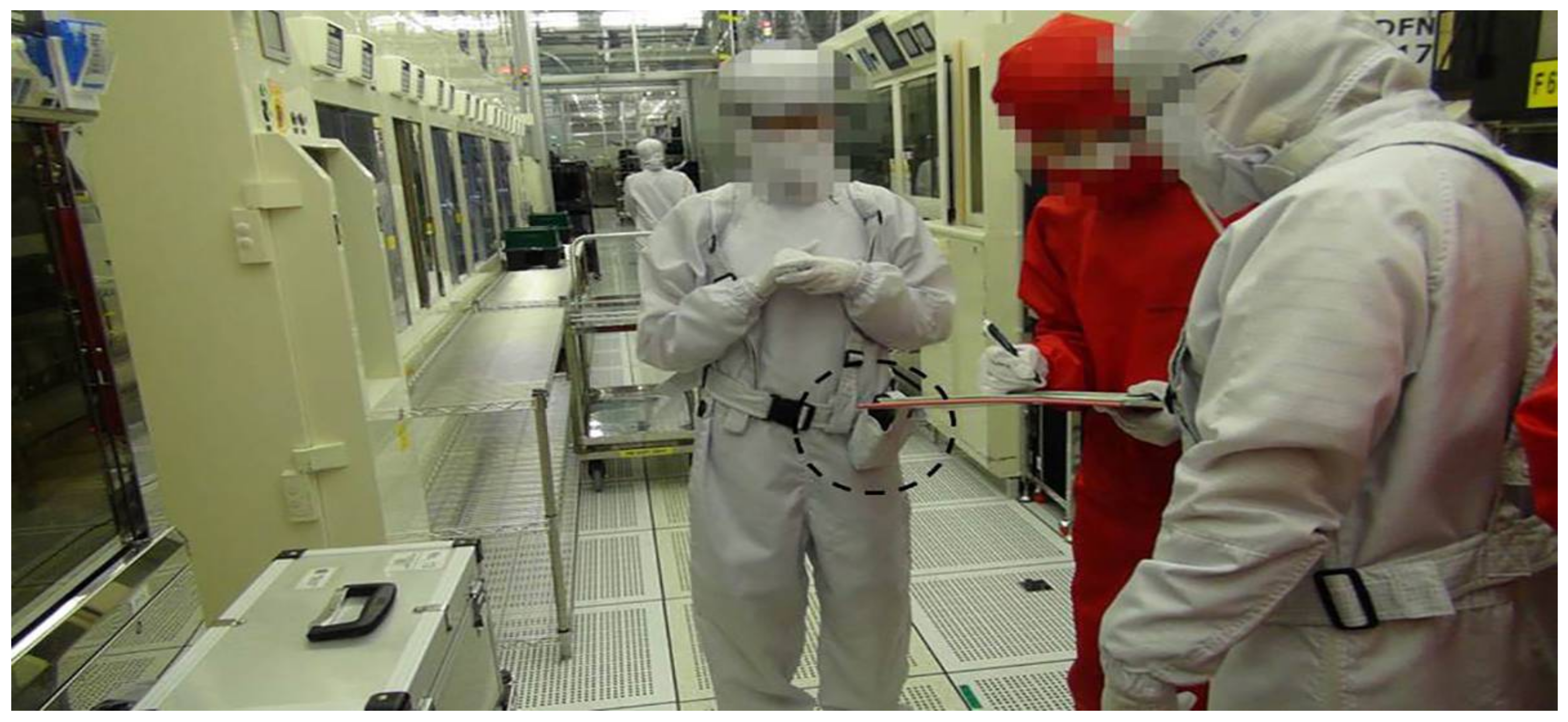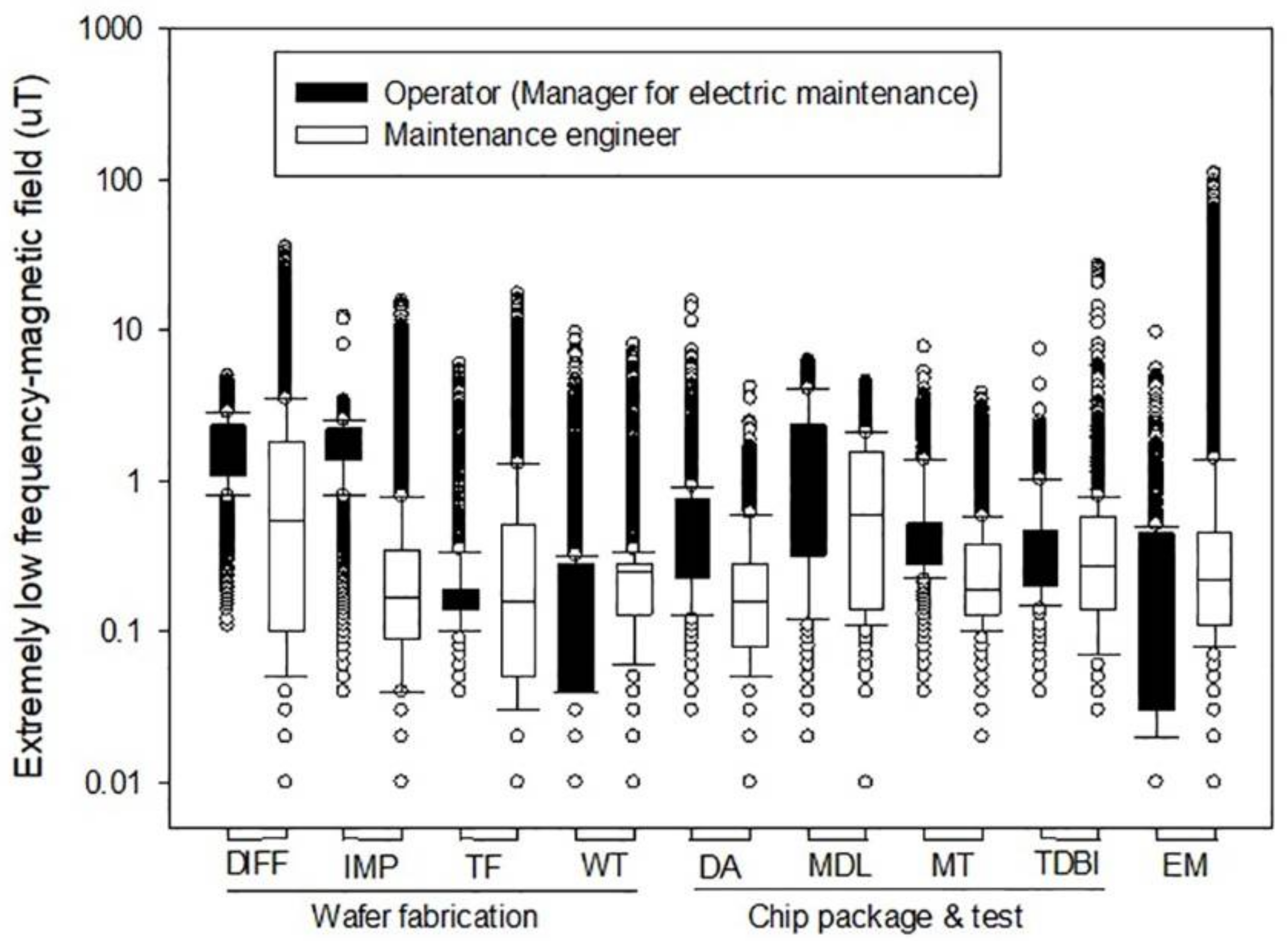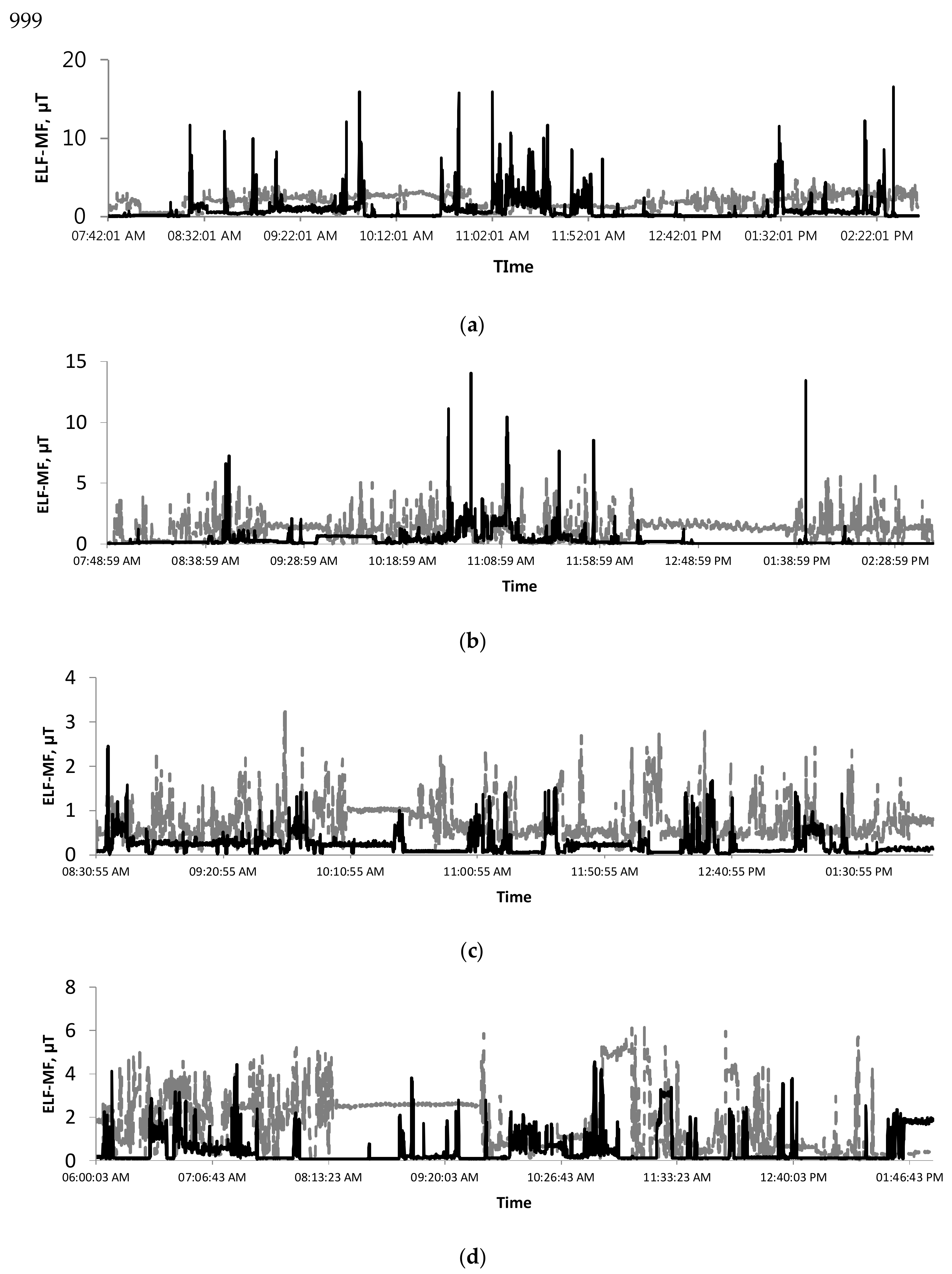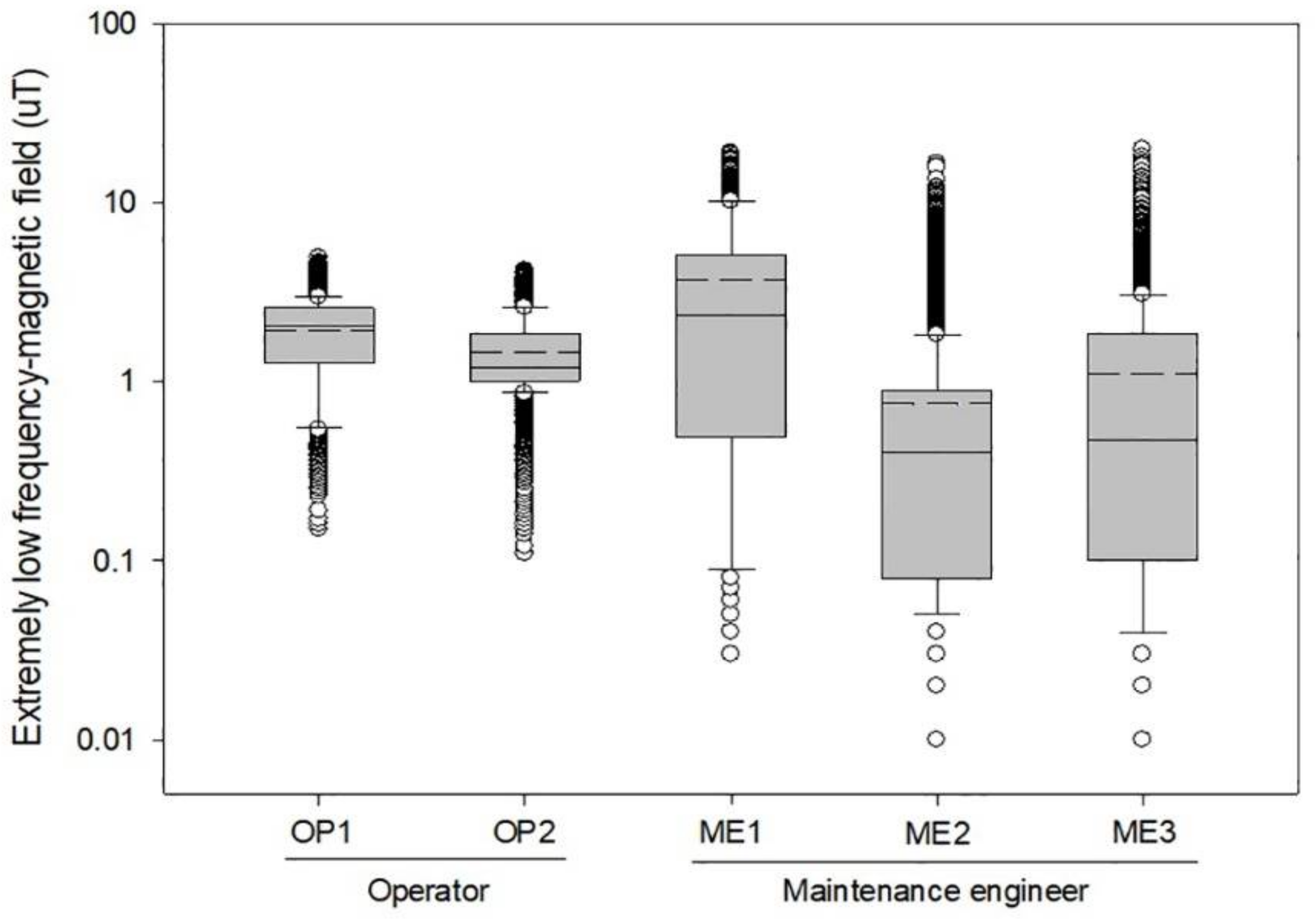Extremely Low Frequency-Magnetic Field (ELF-MF) Exposure Characteristics among Semiconductor Workers
Abstract
:1. Introduction
2. Materials and Methods
2.1. Study Plant
2.2. Overview of Semiconductor Operations
- Patterning—oxidation, photolithography, developing, etching, and stripping
- Junction formation—diffusion and ion implantation
- Deposition—epitaxial or chemical vapor deposition
- Metallization—sputtering and evaporation
2.3. ELF-MF Exposure Assessment Strategy
2.4. Classification of ELF-MF Measurements
- Type of semiconductor factory; fab and chip package factory
- Clean room vs non-clean room. The measurements recorded were dichotomized into clean and non-clean room.
- Type of job: operator, maintenance engineer, electric engineer and electric maintenance manager of. The electric maintenance manager performed administrative work in an office located outside a clean room.
- Type of operation: Operations within two types of semiconductor plant were categorized according to the operation to which workers were assigned.
- Microenvironments of location or job and activity performed: Locations where workers spent time or activities and jobs that workers performed were categorized: rest in clean room, rest outside cleanroom, near or passing electric devices assumed to be a source of ELF-MF and type of work activity, such as maintenance or operation.
2.5. Data Analysis
3. Results
4. Discussion
5. Conclusions
Author Contributions
Conflicts of Interest
References
- Repacholi, M. Concern that “EMF” magnetic fields from power lines cause cancer. Sci. Total Environ. 2012, 426, 454–458. [Google Scholar] [CrossRef] [PubMed]
- Charbotel, B.; Fervers, B.; Droz, J. Occupational exposures in rare cancers: A critical review of the literature. Crit. Rev. Oncol. Hematol. 2014, 90, 99–134. [Google Scholar] [CrossRef] [PubMed]
- Turner, M.C.; Benke, G.; Bowman, J.D.; Figuerola, J.; Fleming, S.; Hours, M.; Kincl, L.; Krewski, D.; McLean, D.; Parent, M.-E. Occupational exposure to extremely low-frequency magnetic fields and brain tumor risks in the INTEROCC study. Cancer Epidemiol. Biomark. 2014, 23, 1863–1872. [Google Scholar] [CrossRef] [PubMed]
- Van der Mark, M.; Vermeulen, R.; Nijssen, P.C.; Mulleners, W.M.; Sas, A.M.; van Laar, T.; Kromhout, H.; Huss, A. Extremely low-frequency magnetic field exposure, electrical shocks and risk of Parkinson’s disease. Int. Arch. Occup. Environ. Health 2015, 88, 227–234. [Google Scholar] [CrossRef] [PubMed]
- Navas-Acién, A.; Pollán, M.; Gustavsson, P.; Floderus, B.; Plato, N.; Dosemeci, M. Interactive effect of chemical substances and occupational electromagnetic field exposure on the risk of gliomas and meningiomas in Swedish men. Cancer Epidemiol. Biomark. Prev. 2002, 11, 1678–1683. [Google Scholar]
- International Agency for Research on Cancer. Non-Ionizing Radiation: Static and Extremely Low-Frequency (ELF) Electric and Magnetic Fields. 2002. Available online: http://monographs.iarc.fr/ENG/Monographs/vol80/ (accessed on 4 April 2016).
- World Health Organization. Extremely Low Frequency Fields Environmental Health Criteria Monograph 238. 2007. Available online: http://www.who.int/peh-emf/publications/ (accessed on 4 April 2016).
- Abdollahzadeh, S.; Katharine, S.H.; Schenker, M.B. A model for assessing occupational exposure to extremely low-frequency magnetic fields in fabrication rooms in the semiconductor health study. Am. J. Ind. Med. 1995, 28, 723–734. [Google Scholar] [CrossRef] [PubMed]
- Wald, P.H.; Jones, J.R. Semiconductor manufacturing: An introduction to processes and hazards. Am. J. Ind. Med. 1987, 11, 203–221. [Google Scholar] [CrossRef] [PubMed]
- Ahlbom, I.; Cardis, E.; Green, A.; Linet, M.; Savitz, D.; Swerdlow, A.; Epidemiology, I.S.C. Review of the epidemiologic literature on EMF and health. Environ. Health Perspect. 2001, 109 (Suppl. 6), 911–933. [Google Scholar] [CrossRef] [PubMed]
- Chelton, C.; Glowatz, M.; Mosovsky, J. Chemical hazards in the semiconductor industry. IEEE T. Educ. 1991, 34, 269–288. [Google Scholar] [CrossRef]
- Singapore Ministry of Manpower. A Guide on Health Hazards and Their Control in Wafer Fabrication Facilities. Report on Workplace Safety and Health, Occupational Safety & Health Division, Singapore: 1998. Available online: http://safety.com.sg/pds/files/pdf/A%20Guide%20on%20Health%20Hazards%20&%20Their%20Control%20in%20Wafer%20Fabrication%20Facilities.pdf (accessed on 27 March 2018).
- Bowman, J.D.; Touchstone, J.A.; Yost, M.G. A population-based job exposure matrix for power-frequency magnetic fields. J. Occup. Environ. Hyg. 2007, 4, 715–728. [Google Scholar] [CrossRef] [PubMed]
- Kaune, W.; Davis, S.; Stevens, R.; Mirick, D.; Kheifets, L. Measuring temporal variability in residential magnetic field exposures. Bioelectromagnetics 2001, 22, 232–245. [Google Scholar] [CrossRef] [PubMed]
- Rosenthal, F.S.; Abdollahzadeh, S. Assessment of extremely low frequency (ELF) electric and magnetic fields in microelectronics fabrication rooms. Appl. Occup. Environ. Hyg. 1991, 6, 777–784. [Google Scholar] [CrossRef]
- Chung, E.K.; Kim, K.B.; Chung, K.J.; Lee, I.S.; You, K.H.; Park, J.-S. Occupational exposure of semiconductor workers to ELF magnetic fields. J. Korean Soc. Occup. Env. Hyg. 2012, 22, 42–51. [Google Scholar]
- Ahlbom, A.; Bergqvist, U.; Bernhardt, J.; Cesarini, J.; Grandolfo, M.; Hietanen, M.; Mckinlay, A.; Repacholi, M.; Sliney, D.; Stolwijk, J.A. Guidelines for limiting exposure to time-varying electric, magnetic, and electromagnetic fields (up to 300 GHz). Health Phys. 1998, 74, 494–521. [Google Scholar]
- American Conference of Governmental Industrial Hygienist. Threshold Limit Values for Chemical Substances and Physical Agents and Biological Exposure Indices; American Conference of Governmental Industrial Hygienist: Cincinnati, OH, USA, 2017; pp. 123–127. ISBN 978-1-607260-77-6. [Google Scholar]
- Mild, K.; Sandström, M. Guide Electromagnetic Fields in Working Life. A Guide to Risk Assessment. European Trade Union Institute, 2015. Available online: http://www.etui.org/Publications2/Guides/Electromagnetic-fields-in-working-life.-A-guide-to-risk-assessment (accessed on 4 April 2016).
- Chen, C.; Ma, X.; Zhong, M.; Yu, Z. Extremely low-frequency electromagnetic fields exposure and female breast cancer risk: A meta-analysis based on 24,338 cases and 60,628 controls. Breast Cancer Res. Treat. 2010, 123, 569–576. [Google Scholar] [CrossRef] [PubMed]
- Chen, Q.; Lang, L.; Wu, W.; Xu, G.; Zhang, X.; Li, T.; Huang, H. A meta-analysis on the relationship between exposure to ELF-EMFs and the risk of female breast cancer. PLoS ONE. 2013, 8, e69272. [Google Scholar] [CrossRef] [PubMed]
- Zhang, Y.; Lai, Y.; Ruan, G.; Chen, C.; Wang, D.W. Meta-analysis of extremely low frequency electromagnetic fields and cancer risk: A pooled analysis of epidemiologic studies. Environ. Int. 2016, 88, 36–43. [Google Scholar] [CrossRef] [PubMed]
- Håkansson, N.; Stenlund, C.; Gustavsson, P.; Johansen, C.; Floderus, B. Arc and resistance welding and tumours of the endocrine glands: A Swedish case-control study with focus on extremely low frequency magnetic fields. Occup. Environ. Med. 2005, 62, 304–308. [Google Scholar] [CrossRef] [PubMed]
- Lee, H.E.; Kim, E.A.; Park, J.S.; Kang, S.G. Cancer mortality and incidence in Korean semiconductor workers. Saf. Health Work 2011, 2, 135–147. [Google Scholar] [CrossRef] [PubMed]
- Park, S.H.; Shin, J.A.; Park, H.H.; Yi, G.Y.; Chung, K.J.; Park, H.D.; Kim, K.B.; Lee, I.S. Exposure to volatile organic compounds and possibility of exposure to by-product volatile organic compounds in photolithography processes in semiconductor manufacturing factories. Saf. Health Work 2011, 2, 210–217. [Google Scholar] [CrossRef] [PubMed]
- Kheifets, L.; Bowman, J.D.; Checkoway, H.; Feychting, M.; Harrington, J.M.; Kavet, R.; Marsh, G.; Mezei, G.; Renew, D.C.; van Wijngaarden, E. Future needs of occupational epidemiology of extremely low frequency electric and magnetic fields: Review and recommendations. Occup. Environ. Med. 2009, 66, 72–80. [Google Scholar] [CrossRef] [PubMed]




| Classification | Operation | No. of Workers | No. of Observations | AM, µT | SD, µT | GM, µT | GSD | Range, µT |
|---|---|---|---|---|---|---|---|---|
| Fabrication * | CMP | 6 | 44,242 | 0.14 | 0.29 | 0.09 | 2.47 | 0.01–16.83 |
| Photolithography | 6 | 53,883 | 0.53 | 0.46 | 0.37 | 2.54 | 0.02–21.97 | |
| Etch | 11 | 98,151 | 0.53 | 0.64 | 0.37 | 2.40 | 0.01–23.52 | |
| Diffusion | 8 | 58,672 | 1.48 | 2.00 | 0.64 | 4.50 | 0.01–35.36 | |
| Ionimplantation | 8 | 60,650 | 0.76 | 0.95 | 0.32 | 4.18 | 0.01–15.67 | |
| Thin-film | 8 | 66,598 | 0.43 | 0.77 | 0.18 | 3.64 | 0.01–17.31 | |
| Wafertest | 11 | 92,819 | 0.21 | 0.29 | 0.14 | 2.62 | 0.01–9.63 | |
| Total | 58 | 475,015 | 0.56 | 0.99 | 0.25 | 3.61 | 0.01–35.36 | |
| Chip packaging * | Dieattach | 8 | 69,152 | 0.46 | 0.38 | 0.33 | 2.41 | 0.01–15.39 |
| Module | 5 | 47,401 | 1.13 | 1.16 | 0.59 | 3.56 | 0.01–6.27 | |
| Moduletest | 11 | 105,017 | 0.39 | 0.43 | 0.27 | 2.24 | 0.02–7.71 | |
| TDBI | 14 | 105,812 | 0.39 | 0.39 | 0.28 | 2.32 | 0.03–26.72 | |
| Test | 7 | 32,480 | 1.46 | 0.90 | 1.24 | 1.80 | 0.08–21.92 | |
| Total | 45 | 359,862 | 0.59 | 0.71 | 0.36 | 2.73 | 0.01–26.72 | |
| Electric maintenance * | Maintenance | 12 | 91,481 | 0.89 | 3.11 | 0.27 | 3.55 | 0.01–109.00 |
| Management | 2 | 16,526 | 0.28 | 0.42 | 0.13 | 4.06 | 0.01–9.66 | |
| Total | 14 | 108,007 | 0.80 | 2.88 | 0.24 | 3.73 | 0.01–109.00 |
| Classification | Type of Job | No. of Workers | No. of Observations | AM, µT | SD, µT | GM, µT | GSD | Range, µT |
|---|---|---|---|---|---|---|---|---|
| Fabrication * | Operator | 13 | 106,987 | 0.68 | 0.85 | 0.27 | 4.23 | 0.01–12.31 |
| M/E | 45 | 368,028 | 0.53 | 1.02 | 0.25 | 3.43 | 0.01–35.36 | |
| Chip packaging * | Operator | 22 | 155,994 | 0.82 | 0.86 | 0.54 | 2.52 | 0.02–21.92 |
| M/E | 23 | 203,868 | 0.42 | 0.51 | 0.26 | 2.57 | 0.01–26.72 | |
| Electric maintenance * | Engineer | 12 | 91,481 | 0.89 | 3.11 | 0.27 | 3.55 | 0.01–109.0 |
| Manager | 2 | 16,526 | 0.28 | 0.42 | 0.13 | 4.06 | 0.01–9.66 |
| Classification | Type of Activity or Location | No. of Observations | AM, µT | SD, µT | GM, µT | GSD | Range, µT |
|---|---|---|---|---|---|---|---|
| Fabrication * | Resting outside clean room | 51,953 | 0.27 | 0.25 | 0.17 | 2.73 | 0.01–2.51 |
| Resting inside clean room | 19,632 | 0.77 | 0.54 | 0.60 | 2.11 | 0.03–2.65 | |
| Operation work | 91,603 | 0.66 | 0.85 | 0.26 | 4.28 | 0.01–3.45 | |
| Maintenance work | 14,952 | 3.34 | 3.24 | 2.32 | 2.36 | 0.05–35.36 | |
| Near or passing process machine | 296,875 | 0.43 | 0.60 | 0.22 | 3.27 | 0.01–10.70 | |
| Chip packaging * | Resting outside clean room | 34,056 | 0.23 | 0.47 | 0.13 | 2.20 | 0.03–2.87 |
| Resting inside clean room | 11,353 | 0.55 | 0.60 | 0.37 | 2.22 | 0.09–2.58 | |
| Operation work | 130,620 | 0.73 | 0.60 | 0.54 | 2.21 | 0.02–4.41 | |
| Maintenance work | 16,294 | 2.19 | 1.59 | 1.77 | 1.93 | 0.03–26.72 | |
| Near or passing process machine | 167,539 | 0.41 | 0.42 | 0.27 | 2.45 | 0.01–4.55 | |
| Electric engineer * | Resting outside clean room | 2735 | 0.34 | 0.27 | 0.26 | 2.29 | 0.02–3.48 |
| Resting inside clean room | 994 | 1.17 | 0.79 | 0.69 | 3.62 | 0.01–2.87 | |
| Maintenance work | 3421 | 11.43 | 11.06 | 7.77 | 2.49 | 0.54–109.0 | |
| Near or passing process machine | 84,331 | 0.48 | 0.92 | 0.24 | 2.96 | 0.01–9.99 | |
| Manager of electric maintenance * | Resting outside clean room | 1072 | 0.15 | 0.15 | 0.07 | 3.81 | 0.02–0.35 |
| Office | 15,207 | 0.25 | 0.23 | 0.13 | 3.89 | 0.01–1.95 | |
| Near or passing electric device | 247 | 2.65 | 1.62 | 2.15 | 1.97 | 0.60–9.66 |
| Classification | Operation | Type of Job | No of Samples | AM, uT | SD, uT | GM, uT | GSD | Range, uT | Relative Exposure Group 1 |
|---|---|---|---|---|---|---|---|---|---|
| Fabrication | CMP | M/E | 44,242 | 0.14 | 0.29 | 0.09 | 2.47 | 0.01–16.83 | Low |
| Photolithography | M/E | 53,883 | 0.53 | 0.46 | 0.37 | 2.54 | 0.02–21.97 | Moderate | |
| Etch | M/E | 98,151 | 0.53 | 0.64 | 0.37 | 2.40 | 0.01–23.52 | Moderate | |
| Diffusion | Operator | 16,869 | 1.69 | 0.81 | 1.48 | 1.71 | 0.11–4.93 | High | |
| M/E | 41,803 | 1.40 | 2.30 | 0.46 | 5.10 | 0.01–35.36 | High | ||
| Ion implantation | Operator | 17,099 | 1.74 | 0.68 | 1.50 | 1.97 | 0.04–12.31 | High | |
| M/E | 43,551 | 0.37 | 0.74 | 0.17 | 3.20 | 0.01–15.67 | Low | ||
| Thin film | Operator | 8395 | 0.24 | 0.40 | 0.18 | 1.86 | 0.04–5.93 | Low | |
| M/E | 58,203 | 0.45 | 0.81 | 0.18 | 3.90 | 0.01–17.31 | Moderate | ||
| Wafer test | Operator | 64,624 | 0.19 | 0.25 | 0.12 | 2.66 | 0.01–9.63 | Low | |
| M/E | 28,195 | 0.27 | 0.36 | 0.19 | 2.34 | 0.01–7.99 | Low | ||
| Chip packaging | Die attach | Operator | 51,536 | 0.53 | 0.39 | 0.41 | 2.10 | 0.03–15.39 | Moderate |
| M/E | 17,616 | 0.25 | 0.26 | 0.16 | 2.41 | 0.01–4.17 | Low | ||
| Module | Operator | 18,601 | 1.46 | 1.48 | 0.76 | 3.67 | 0.02–6.27 | High | |
| M/E | 28,800 | 0.91 | 0.82 | 0.50 | 3.38 | 0.01–4.55 | High | ||
| Module test | Operator | 28,799 | 0.56 | 0.52 | 0.43 | 1.99 | 0.04–7.71 | Moderate | |
| M/E | 76,218 | 0.32 | 0.37 | 0.23 | 2.17 | 0.02–3.81 | Moderate | ||
| TDBI | Operator | 24,578 | 0.43 | 0.34 | 0.33 | 2.00 | 0.04–7.43 | Moderate | |
| M/E | 81,234 | 0.37 | 0.40 | 0.26 | 2.40 | 0.03–26.72 | Moderate | ||
| Test | Operator | 32,480 | 1.46 | 0.90 | 1.24 | 1.80 | 0.08–21.92 | High | |
| Electric maintenance | Maintenance | M/E | 91,481 | 0.89 | 3.11 | 0.27 | 3.55 | 0.01–109.0 | High |
| Management | Manager | 16,526 | 0.28 | 0.42 | 0.13 | 4.06 | 0.01–9.66 | Low |
© 2018 by the authors. Licensee MDPI, Basel, Switzerland. This article is an open access article distributed under the terms and conditions of the Creative Commons Attribution (CC BY) license (http://creativecommons.org/licenses/by/4.0/).
Share and Cite
Choi, S.; Cha, W.; Park, J.; Kim, S.; Kim, W.; Yoon, C.; Park, J.-H.; Ha, K.; Park, D. Extremely Low Frequency-Magnetic Field (ELF-MF) Exposure Characteristics among Semiconductor Workers. Int. J. Environ. Res. Public Health 2018, 15, 642. https://doi.org/10.3390/ijerph15040642
Choi S, Cha W, Park J, Kim S, Kim W, Yoon C, Park J-H, Ha K, Park D. Extremely Low Frequency-Magnetic Field (ELF-MF) Exposure Characteristics among Semiconductor Workers. International Journal of Environmental Research and Public Health. 2018; 15(4):642. https://doi.org/10.3390/ijerph15040642
Chicago/Turabian StyleChoi, Sangjun, Wonseok Cha, Jihoon Park, Seungwon Kim, Won Kim, Chungsik Yoon, Ju-Hyun Park, Kwonchul Ha, and Donguk Park. 2018. "Extremely Low Frequency-Magnetic Field (ELF-MF) Exposure Characteristics among Semiconductor Workers" International Journal of Environmental Research and Public Health 15, no. 4: 642. https://doi.org/10.3390/ijerph15040642





